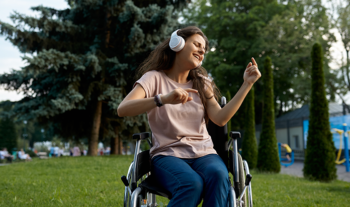As children enter their teenage years, the desire to rebel is ubiquitous almost to the point of cliché. But what about those young people with chronic diseases whose burgeoning independence heralds a new era in their medical management?
Parents and carers who are used to helping their children manage their health conditions can find it difficult to step back. They find it hard to allow young people to find their own ways of managing their conditions – and making their own mistakes.
Case studies of teens living with chronic illness
-
Adam
A recent case study followed Adam [mfn]Transition from pediatric to adult-oriented health care: a challenge for patients with chronic disease Callahan, S. Todd MD; Winitzer, Rebecca Feinstein MS, MSW; Keenan, Peter RN, MS, PNP Current Opinion in Pediatrics: August 2001 – Volume 13 – Issue 4 – p 310-316 Adolescent medicine[/mfn], a type 1 diabetic who’d been managing his blood sugar monitoring and insulin regime with increasing independence since he was at primary school. In his teens, he began regularly attending his local A&E department with life-threatening diabetic ketoacidosis, requiring admission to ICU on three occasions in the months after his 15th birthday.
He was quiet and withdrawn at appointments with his consultant and barely spoke to his parents. His specialists knew that he was aware of the risks of poor management. And that he was very capable of looking after his diabetes, yet he continued regularly becoming seriously ill.
-
James
James’ case highlights the impact of chronic illness on teenagers, and the fine line between self-neglect, rebellion, and deliberate self-harm in adolescents who manage their own long-term conditions. External influences weighed heavily on James. In this case, wanting to be like his friends. In particular, he starting drinking alcohol and finding himself unable to manage his blood sugars. And so in frustration gave up on his insulin regime. This is typical, almost unavoidable, and requires understanding and careful management.
Teens and chronic Illness
Chronic illness can refer to a wide spectrum of needs ranging from profound learning disability, total physical care needs and communication difficulties all the way through to people with less serious problems. Less serious illnesses, such as eczema or allergies, still require good management practices and can have a significant impact on general wellbeing.
The level of input people with chronic conditions requires varies widely, but there are some issues common to almost all adolescents with long-term conditions. There are, however, some people who may never be able to take any control of their condition or care needs.
Growing up with chronic illness
Teenagers with health needs requiring regular input from specialists are likely to be transferred at some point from pediatric to adult services. This may mean that they will be expected to have a higher degree of self-management, to engage independently with services, and to advocate for themselves when they meet barriers.
The close families of these young people are in a unique position. They can help equip their teens for their future self-management, and get them through the often-difficult adolescent years, promoting independence without mutiny.
Some areas have trialed specific transitional clinics designed to ensure a straightforward switch between pediatric and adult services[i].
Addressing barriers to chronic illness management for teens
-
Fitting in
Teens want to be like their friends but they also want to be unique. They don’t have to be subject to pressure from their peers to want to fit in. They get that from within.
Any engagement with external influences can give a glimpse of a different, more desirable lifestyle. And, it’s rare that a leading role in movies or television series will be someone with a disability or chronic healthcare needs. How idyllic are the lives of TV characters who are never shown injecting themselves with insulin, discretely managing their stoma or missing parties at venues without ramps or elevators?
-
Body image
At a time of physical changes, of increasing variation from person to person, and emerging awareness of sexuality and appearance, most young people will struggle with self-image at some point. This can be particularly problematic in people with chronic health conditions, and not just those affecting their physical appearance. Family support is important, but the influence of peers, media, and societal attitudes to health and appearance are profound and need to be addressed both at home and in a wider context.
-
Risky behavior
The teenage years are well-known to be the time when people experiment with previously forbidden behaviors. This is the time when people start having sex, smoking, drinking alcohol or taking illicit drugs. And this seems to be even more prevalent in teenagers with chronic conditions.[mfn]Health Risk Behaviors in Adolescents With Chronic Conditions Joan-Carles Surís, Pierre-André Michaud, Christina Akre, Susan M. Sawyer Pediatrics Nov 2008, 122 (5) e1113-e1118; https://doi.org10.1542/peds.2008-1479[/mfn]
Some conditions may even reduce the teenagers’ ability to assess risk or might mean that they feel indifferent to risks to their health. In addition, some medications can be affected by the use of illicit drugs or alcohol. This can place them more at risk of significant problems caused by drug interactions.
Mitigating these kinds of risks requires a multi-agency approach. A cohesive front at home, school, and any specialist services promoting an atmosphere of openness, safety, and responding without judgment or criticism.
-
Shifting responsibility
This is the time when many young people have to become independent with their medical routine. When they were very young it was easy to advise them, to make sure they used their inhalers, applied their creams, took their tablets.
Now they have bodily autonomy, and they might not want to involve their parents when they’re having symptoms. And they may not want to admit that they are struggling to fully manage their condition themselves.
Starting early, where possible, can have good results. Even from a fairly young age, many children can take a degree of ownership over their condition and treatment, meaning a smoother transition to greater independence.
-
Bullying
Teenagers can be CRUEL. Children can be cruel. Adults can also be cruel but they’ve usually learned to hide it at least a little.
Physical or face-to-face abuse is nothing new, and it can be horrific and difficult to deal with. Institutions such as schools and care settings will have a lot of experience with bullying and should have robust measures in place to address these issues.
However, teenagers now have more avenues for cruelty and bullying than ever before. With the relative anonymity of social media, cyberbullying allows for some extremely nasty behavior. The flip side of this is that people with chronic conditions and people experiencing bullying have access to a huge network of people in similar positions, and support can come thick and fast.
Related Content: Helping Your Child Deal With Bullies: What You Can Do
-
Gender differences
People’s likelihood to access healthcare has historically been gender-related. Broadly, and with due respect to shifting attitudes towards historic gender roles, women go to see their doctor more than men do.
Traditionally they more likely need to access medical services because of the burden of contraception, pregnancy, and birth. In addition to more likely being the main carer for young children and so attend child health checks. Women have been simply more used to routinely accessing healthcare.
This has led to some discrepancies between men and women accessing services[mfn]Doyal, L., Payne, S. and Cameron, A. (2003) Promoting gender equality in health, Working Paper 11, Manchester: Equal Opportunities Commission[/mfn], which may influence any young person in a household. Add to this a continued, though hopefully changing, pressure particularly on boys and men to be ‘strong’ and not show perceived weakness.
Thus, we have the perfect conditions for teenage boys to hide or revolt against their medical needs. In contrast to this, though, some studies have found teenage boys with chronic conditions to have objectively higher expectations for their physical fitness. Girls, on the other hand, seemingly adapt more around their condition[mfn]Williams, C. (2000) Doing health, doing gender: teenagers, diabetes and asthma Social Science & Medicine Volume 50, Issue 3, February 2000, Pages 387-396 https://doi.org/10.1016/S0277-9536(99)00340-8[/mfn] –this too could influence individual teens’ access to healthcare.
The bottom line
The effect of a supportive, understanding parenting and family approach in promoting health in young people and not just those with chronic health conditions, is paramount. Allowing teenagers to develop essential autonomy while overseeing the management of their health needs can be tricky.
It can be particularly hard for parents to relinquish control when they’ve always taken charge of their children’s health and care needs. The very time when young people may be able to learn to manage their chronic conditions coincides with the period in their lives with the most hormonal, emotional and physical upheaval[mfn]Yeo, M and Sawyer, S. (2005) Chronic illness and disability BMJ; 330: 721 https://doi.org/10.1136/bmj.330.7493.721[/mfn].
The natural changes of adolescence impact heavily on chronic condition management and vice-versa – an irony, unfortunately, lost to sardonic teens.
References:
[1] Transition from pediatric to adult-oriented health care: a challenge for patients with chronic disease Callahan, S. Todd MD; Winitzer, Rebecca Feinstein MS, MSW; Keenan, Peter RN, MS, PNP Current Opinion in Pediatrics: August 2001 – Volume 13 – Issue 4 – p 310-316 Adolescent medicine
[2] Health Risk Behaviors in Adolescents With Chronic Conditions Joan-Carles Surís, Pierre-André Michaud, Christina Akre, Susan M. Sawyer Pediatrics Nov 2008, 122 (5) e1113-e1118; https://doi.org10.1542/peds.2008-1479
[3] Doyal, L., Payne, S. and Cameron, A. (2003) Promoting gender equality in health, Working Paper 11, Manchester: Equal Opportunities Commission
[4] Williams, C. (2000) Doing health, doing gender: teenagers, diabetes and asthma Social Science & Medicine Volume 50, Issue 3, February 2000, Pages 387-396 https://doi.org/10.1016/S0277-9536(99)00340-8
[5] Yeo, M and Sawyer, S. (2005) Chronic illness and disability BMJ; 330 :721 https://doi.org/10.1136/bmj.330.7493.721
Elaine Francis, RGN
Website:
https://elainefrancis.com
Elaine Francis is an NMC registered nurse and freelance writer with sixteen years of experience working in front line healthcare in the North East of England. Eight years in coronary care sparked her interest in modifiable risk, realistic medicine and palliative care.
With a lifelong love of the written word, she started creating articles and web content as a medical ghostwriter. And, she recently left cardiology to pursue a career in freelance medical writing.
She gained her nursing registration and BSc (hons) in Practice Development at the University of Northumbria at Newcastle Upon Tyne. Although sure that being able to translate medical evidence into widely accessible information can transform lives, Elaine is continuing to pick up occasional shifts on her old ward; patient care is what it’s all about, after all.
When she’s not working she can be found in thrift stores and vegan cafes or blogging about the transition from nursing to a freelance writing career.














Comment will held for moderation